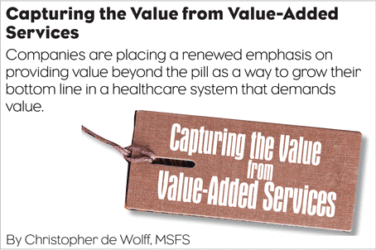With the rise of digital technology, consumers have unprecedented power. When shopping, traveling, and banking, people have become used to individual experiences that span the physical and digital worlds. While other industries are shifting to offer meaningful experiences, available 24/7, healthcare has largely stayed the same. And, until recently, it hasn’t had to change. But under pressure to lower costs and meet ever-rising consumer expectations, healthcare organizations know they must keep up.
But the path ahead is unclear. To understand how healthcare organizations are transforming themselves to be more consumer centric, we interviewed more than 70 healthcare executives across the healthcare ecosystem, including pharma companies such as Pfizer, Novartis, and Eli Lilly and Company. We then surveyed an additional 240 global healthcare executives for further insight. Our report based on this research, “Making the Shift: Healthcare’s Transformation to Consumer-Centricity,” identifies five key shifts to becoming more consumer centric. But we also uncovered sobering statistics citing how far behind healthcare is in this important journey: Fewer than 15% of those in our study have made full progression on any of these necessary changes, revealing a significant opportunity for improvement.
Healthcare has an especially long way to go when it comes to digital innovation. In our survey, only 21% of respondents believe that the most important changes are coming from digital health companies. More strikingly, only 10% say they are comfortable partnering with them. But companies that hesitate to work with digital entities are missing out on not only opportunities to bring innovation to market, but to transform themselves through the partnership.
Another weak spot is metrics and incentives, which are critical to ensure an organization’s associate base is focused on and rewarded for the right things. Only 27% of surveyed companies use consumer loyalty scores such as Net Promoter Scores, for instance, often measuring transactions instead. And when it comes to recruiting leaders from outside their industry, another crucial step in embracing a more consumer-focused perspective, they balk: Only 15% of organizations (although 19% of pharma companies) say they consider such hires.
Here are the changes we believe they must make, even if they’ve made limited progress to date, to become genuinely consumer centric:
SHIFT 1: From Tactical Fixes to an Experience Strategy
While healthcare organizations often start enhancing consumer experiences through one-off initiatives, they need to move toward optimizing the entire healthcare journey. Doing so requires establishing a vision, hiring the right leaders, and creating an experiential plan to win with consumers.
Healthcare companies can:
Set a bold vision that guides and inspires. For a place like Mayo Clinic, where patient-centered care is the bedrock of the culture, this is of utmost importance. “When you try to introduce a new idea, you are likely to face resistance,” Mayo Clinic President and CEO, Dr. John Noseworthy, tells us. “But if you can put the idea in the context of patient-centered care, they will love it and innovate around it.”
Build customer experience capabilities and internal momentum. Engaging employees at all levels helps. Indiana University Health garnered support for its new consumer promise, which informs all its experiences, services, and products, by working with a team of cross-functional leaders to co-create the pledge. The team also got input from over 7,000 team members and consumers in its creation. “We believe that it was critical for team members to be a part of the development of our promise,” says IU Health’s Mike Yost. “We want them to own it and to feel proud delivering on it.”
SHIFT 2: From Fragmented Care to Connected Ecosystems
Although payers, providers, and pharma companies are finding new ways to work together, the healthcare journey is still fragmented for most patients, causing frustration, inefficiencies, and dissatisfaction. Operating in a healthcare ecosystem, rather than as a stand-alone entity, is the only way those in the healthcare value chain will thrive in the future.
One way to make these connections is through a three-step framework, described to us by Jean-Michel Cossery, former Vice President of Oncology, North America at Eli Lilly and Company.
In Stage 1, the product phase, organizations offer a drug, service, or plan for patients with a certain condition. This is the primary product. In Stage 2, which we call the product plus phase, the company evolves to offer this drug, service, or plan along with “wrap-around” services, such as educational materials, patient-support programs, and digital tools. The primary objective is still to sell the product, but also to augment it and drive differentiation. The third phase, which we call plus product, is more connected. The organization provides solutions, layering in products and services as needed to drive the desired outcome. The components will often fall outside the walls of a single organization, requiring coordination and partnership.
Roche’s acquisition of digital health startup, mySugr, is a move toward a “plus product” solution for diabetic patients.
SHIFT 3: From Population-Centric to Person-Centered
Healthcare organizations must move away from creating products, services, and experiences for groups of similar consumers, such as those who have the same condition or those that fall into the same demographic. To begin to create these, companies can:
Move from populations to groups. To better serve different groups of people, start with a better grasp of various patient profiles. This requires getting to know consumers beyond their demographics. Building on the momentum of its rebranding, Novant Health, for example, gained rich consumer insights through a rigorous consumer segmentation exercise that combined market research and the continuous flow of data to improve the consumer experience, including existing and potential patients and caregivers. It led to six key segments. Two of those were given top priority, generating quick successes.
Move from groups to individuals. Once companies understand groups of consumers, they can begin to use real-time insights to personalize experiences. Blue Cross Blue Shield of Florida is using voice-recognition technology to detect consumers’ tone of voice, matching them with an advocate whose personality is best suited to handle angry people, for example, or those who sound confused.
SHIFT 4: From Incremental Improvements to Pervasive Innovation
Instead of settling for small and time-consuming improvements to already-established systems and processes, organizations should strive for true innovation. They can:
Apply a minimum viable product approach. Recognizing that commitment to a classic scientific approach stifles commercial innovation, organizations are borrowing the minimum viable product (MVP) approach from the tech world. Rather than waiting until a product is perfect, an organization will release it as version 1.0 and then continue to make updates until the product is final. Advocate Aurora Health understood that overhauling its entire scheduling system would be a painful, and possibly unsuccessful, feat. So it started in just one area with a project called “Call Today, Be Seen Today,” which allowed same-day scheduling for mammograms. When the system experienced double-digit growth, it expanded the initiative to include same-day results as well. That success gave it the confidence to move forward with plans for similar offerings to all appointments.
Create an internal startup. Boehringer Ingelheim, a German pharmaceutical company, felt innovation withered under industry regulation and scrutiny. So it created a separate entity, a digital innovation lab it calls BI X, to drive innovation in a new and more agile environment.
SHIFT 5: From Insights as a Function to a Culture of Consumer Obsession
Establishing insights as a function is critical for gathering consumer intelligence, but it’s not enough. Companies need to create a culture of consumer obsession, where everyone keeps the consumer front and center at all times. To make this shift, organizations can:
Build a “consumer-intelligence engine.” These engines create a holistic picture of who the consumer is based on a breadth of data. The team needs to be skilled in conducting in-depth primary research and harnessing insights from transactional and behavioral data. They should be able to craft meaningful stories from disparate sources, showing a narrative arc of the customer experience.
The job of this engine is to get past the important question of “how we are doing,” with metrics such as website visits and campaign impressions, to the more important one: “What should we be doing?” And this extends beyond campaign insights to inform development and execution of the plus product solution referenced above.
Establish processes to gather and share data across business units. Often, research is conducted and never used, not because it wasn’t insightful, but because it didn’t provide the intelligence needed to inform business decisions. Companies that do this best have a partnership between insights and the business team and have codified ways to routinely inventory data and insights, identify gaps, and build an intelligence brief.
No Pain, No Gain
Becoming truly consumer centric in the healthcare industry is no easy feat. It requires hard work, and progress can often seem to be in the hands of unpredictable and ever-changing market conditions. But the rewards of making these shifts are well worth the struggle, bettering the healthcare industry for patients, physicians, and pharmaceutical companies.
In a world where healthcare organizations have made the five shifts, consumers would not only have a voice similar to other industries, but also the ability to manage their health in a way that keeps them well and out of the hospital. Ultimately, that will lead to lower costs, better outcomes, and greater affinity for the organizations that deliver it.









